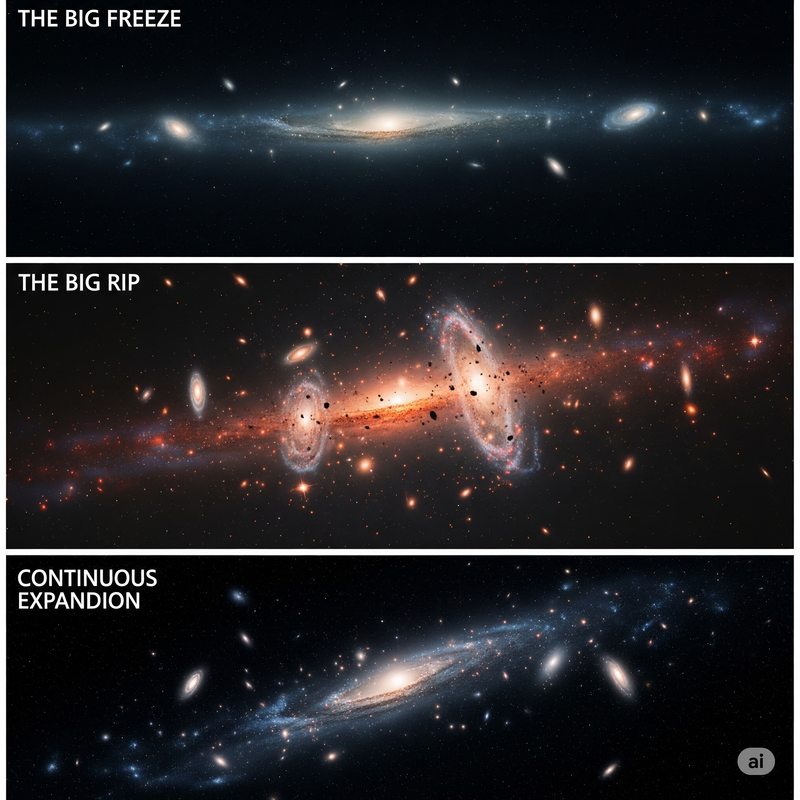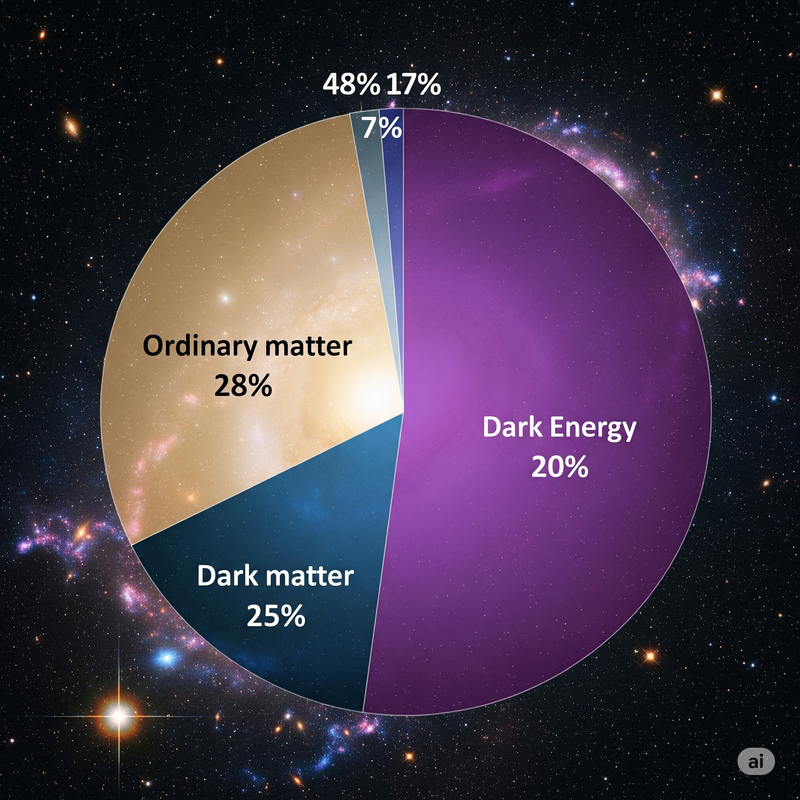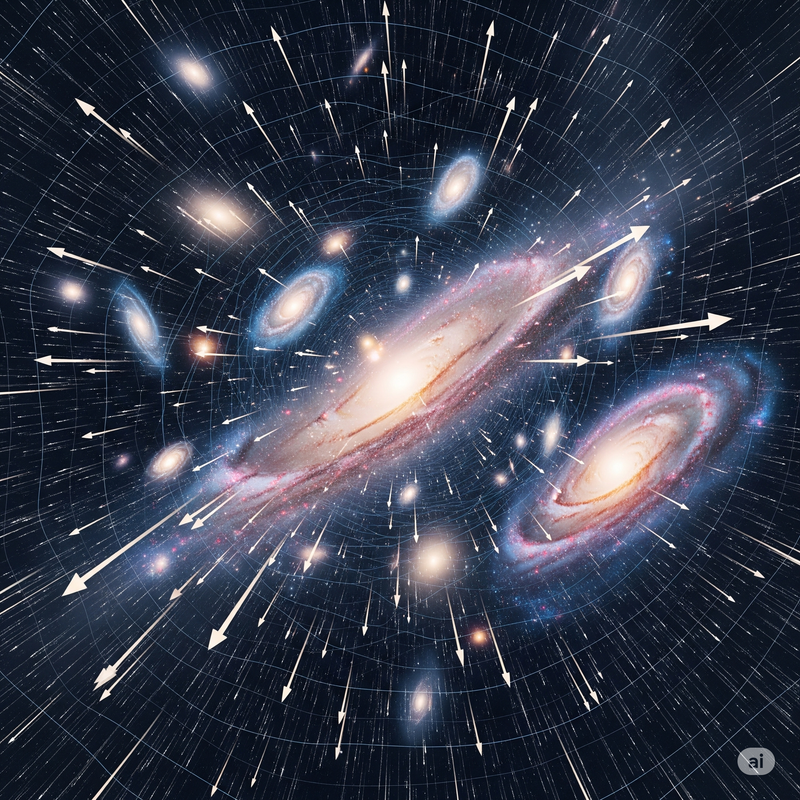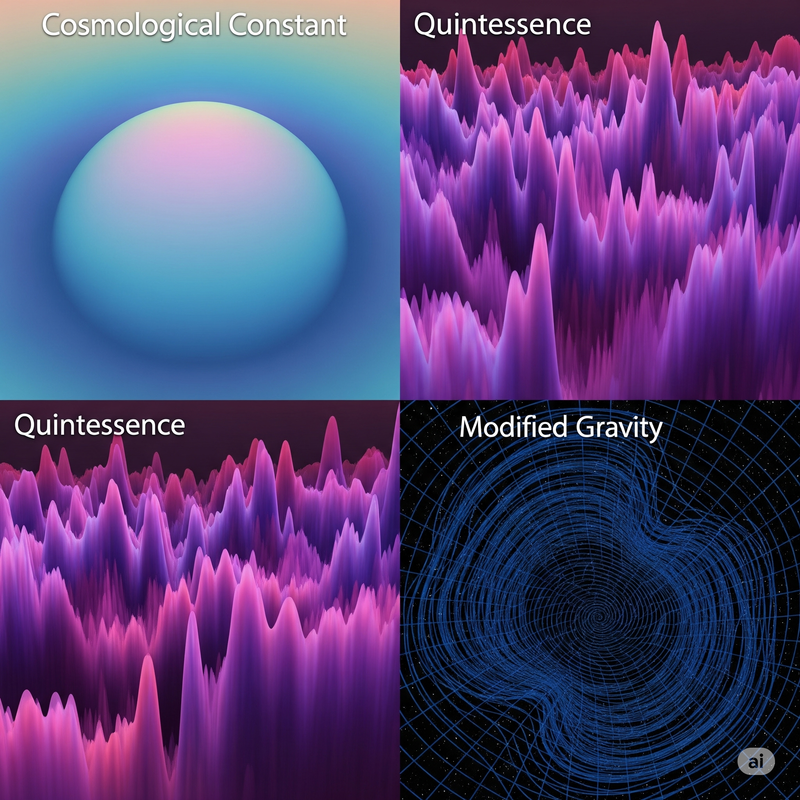Dark Energy: The Mysterious Force Tearing the Universe Apart
Dark Energy: The Mysterious Force Tearing the Universe Apart
Published on: May 21, 2025 | Written by Science by Rao

Figure 1: An artistic rendering illustrating the universe's accelerating expansion, with galaxies speeding away from each other, driven by an unseen force.
Abstract: Imagine tossing a ball into the air, expecting it to slow down and fall back due to gravity. Now, imagine it defying gravity, accelerating away from you, faster and faster. This seemingly impossible scenario perfectly describes what astronomers have observed happening to our universe on the largest scales. The culprit is **dark energy**, an enigmatic entity that constitutes the vast majority of our cosmos. Far from slowing down, the universe's expansion is accelerating, a startling revelation confirmed in the late 1990s. This post will delve into the profound mystery of dark energy: exploring its elusive nature, the pivotal discoveries that unveiled its existence, and the chilling implications it holds for the ultimate fate of the cosmos.
1. Introduction: The Universe's Unsettling Acceleration
For much of the 20th century, cosmologists generally agreed that the universe was expanding, a fact solidified by Edwin Hubble's observations of receding galaxies. The prevailing assumption was that gravity, acting on all matter, would eventually slow this expansion, perhaps even reversing it into a "Big Crunch." However, revolutionary observations in the late 1990s shattered this consensus. Two independent teams, studying distant supernovae, made a startling discovery: the universe's expansion wasn't slowing down; it was actually speeding up. This unprecedented acceleration pointed to the existence of a dominant, repulsive force – something entirely new and profoundly mysterious – which we now call **dark energy**. This discovery fundamentally reshaped our understanding of cosmology and ignited one of the most fervent quests in modern science.
2. What Exactly IS Dark Energy? The Great Cosmic Enigma
The truth is, despite two decades of intense research, the precise nature of dark energy remains cosmology's most significant unsolved mystery. It's not ordinary matter, nor is it dark matter; it doesn't clump into galaxies or exert gravitational pull in the traditional sense. Instead, it seems to be a pervasive force or property of space itself, exerting a uniform, repulsive pressure that counteracts gravity. Scientists have put forth several compelling, yet unproven, theoretical possibilities for what dark energy might be:
- Einstein's Cosmological Constant ($\Lambda$): This is the simplest and most favored explanation within the current standard model of cosmology (Lambda-CDM model). Originally introduced by Albert Einstein into his theory of general relativity (then later discarded as his "biggest blunder"), the cosmological constant represents a constant energy density inherent to the vacuum of space itself. In this view, as space expands, more "new" vacuum energy is created, maintaining a constant density and thus a constant repulsive force. The problem, however, is that quantum field theory predicts a vacuum energy vastly larger than what is observed, creating a monumental discrepancy known as the "cosmological constant problem" or "vacuum catastrophe."
- Quintessence: This theory proposes that dark energy is not a constant, but rather a dynamic, time-varying energy field, similar to other fundamental fields (like the Higgs field). The term "quintessence" evokes the ancient Greek concept of a fifth element that permeates the cosmos. Unlike the cosmological constant, quintessence's energy density and pressure could change over time, potentially influencing the universe's expansion rate differently in various cosmic epochs. This flexibility allows for richer cosmological scenarios.
- Modifications to Gravity: Another radical possibility suggests that our understanding of gravity, as described by Einstein's general relativity, might be incomplete or needs modification on very large, cosmological scales. Instead of a new energy component, perhaps the laws of gravity themselves behave differently over immense distances, leading to the observed acceleration. While various "modified gravity" theories exist (e.g., f(R) gravity, DGP model), none have yet consistently explained all cosmological observations as elegantly and comprehensively as general relativity complemented by dark energy.
- Something Entirely New and Unknown: It's also entirely plausible that dark energy is a manifestation of physics beyond our current Standard Model of particle physics and cosmology. It could be a new fundamental force, a new type of particle, or an entirely unprecedented cosmic phenomenon that we have yet to conceive. This open possibility highlights the profound implications of its discovery.

Figure 2: Observations of distant Type Ia supernovae (stellar explosions), acting as cosmic "standard candles," provided the first compelling evidence for the universe's accelerating expansion.
3. What Do We Know About Dark Energy? Observational Pillars
Despite the uncertainty about its fundamental nature, years of meticulous astronomical observations have allowed us to constrain dark energy's properties and role in the cosmos:
- Cosmic Dominance: Current, highly precise measurements from missions like the Planck satellite reveal that dark energy accounts for an astonishing **68%** of the total energy density of the observable universe. This makes it by far the most dominant component, dwarfing both ordinary matter (baryonic matter, ~5%) and dark matter (~27%).
- Uniform Distribution: Unlike matter, which clumps together to form stars, galaxies, and galaxy clusters due to gravity, dark energy appears to be distributed smoothly and uniformly throughout space. It doesn't seem to cluster, which is consistent with the idea of it being an intrinsic property of space itself.
- Negative Pressure: The most defining characteristic inferred from its effects is that dark energy possesses a strong, constant, negative pressure (or tension). This negative pressure is what gives it its repulsive, gravity-opposing properties, causing space to expand at an accelerating rate. Think of it like a spring that pushes outwards, distributed everywhere.
- Increasing Influence Over Time: As the universe expands, the density of matter and radiation decreases because their amount is fixed within an increasing volume. However, if dark energy's density remains constant (as in the cosmological constant model), its proportion relative to matter and radiation increases over time. This growing relative influence means its repulsive effects become more dominant as the universe ages, leading to the observed acceleration today and stronger acceleration in the future.

Figure 3: Conceptual representations of leading theories attempting to explain dark energy, from the cosmological constant to dynamic fields and modified gravity.
4. The Future of the Universe: Scenarios Shaped by Dark Energy
The ultimate destiny of our universe is inextricably linked to the precise nature and future behavior of dark energy. Depending on how dark energy evolves, several dramatic cosmic fates are possible:
- The Big Freeze (Heat Death): This is the most favored scenario if dark energy behaves like a true cosmological constant, maintaining a constant energy density. The universe will continue to expand at an accelerating rate indefinitely. Galaxies will recede beyond each other's observable horizons, eventually becoming so distant that light from them will never reach us. Stars will eventually exhaust their fuel and die, leaving behind only stellar remnants (white dwarfs, neutron stars, black holes). Over incredibly vast timescales, even these remnants will decay, and black holes will evaporate through Hawking radiation. The universe will become an infinitely cold, dark, and empty void – a state of maximum entropy.
- The Big Rip: This more extreme scenario is possible if dark energy is a form of quintessence with an energy density that *increases* over time (a "phantom energy"). In this catastrophic event, the acceleration of the universe's expansion would become so overwhelmingly powerful that it overcomes all other fundamental forces. First, galaxy clusters would be torn apart, then individual galaxies, followed by solar systems, and eventually even planets and atoms. Space itself would expand so violently that it literally rips apart the fabric of matter, leading to a truly devastating end. Current observations, however, do not strongly support this scenario.
- The Big Crunch (Less Favored): While current evidence overwhelmingly points to accelerated expansion, some theoretical models explore the possibility that the nature of dark energy could change in the distant future. If its repulsive force were to weaken significantly, disappear, or even somehow become attractive, the expansion of the universe could eventually slow down, halt, and then reverse. All matter would then begin to contract, collapsing back into an extremely hot, dense singularity – a "Big Crunch" – mirroring the Big Bang. This scenario is currently highly disfavored by all available observational data.
- The Universe Continues to Expand, Mystery Endures: It's also a possibility that our scientific instruments and theoretical frameworks will continue to refine our understanding of dark energy, but its ultimate, long-term behavior might remain elusive. The universe would simply continue its accelerating expansion, its fate subtly unfolding beyond our complete comprehension.

Figure 4: A clear visualization of the universe's composition, highlighting the overwhelming dominance of dark energy and dark matter.
5. The Ongoing Quest: Unraveling the Cosmic Enigma
Unraveling the precise nature of dark energy stands as one of the most pressing and profound challenges in modern astrophysics and cosmology. The scientific community is tirelessly pursuing various avenues to shed light on this cosmic mystery:
- Next-Generation Cosmological Surveys: Upcoming space telescopes and ground-based observatories are designed to provide unprecedented precision in measuring the universe's expansion history, the growth of cosmic structures, and subtle deviations from the standard model. Missions like the **Euclid telescope** (launched 2023), the **Vera C. Rubin Observatory** (under construction), and the **Nancy Grace Roman Space Telescope** (planned) will map billions of galaxies across vast cosmic distances, aiming to provide definitive answers about dark energy's properties and whether it changes over time.
- Laboratory and Particle Physics Experiments: While directly detecting dark energy is incredibly challenging due to its extremely weak interaction with ordinary matter, some theoretical models suggest potential avenues for indirect detection. This could involve searching for subtle effects on fundamental particles, precision measurements of gravitational fields, or exploring modifications to gravity at microscopic scales.
- Theoretical Advancements: Theoretical physicists are rigorously working to develop new models and frameworks that can elegantly explain the observed properties of dark energy, potentially connecting it to fundamental theories of quantum gravity, string theory, or even a deeper understanding of the vacuum itself. The aim is to integrate dark energy seamlessly into a more complete theory of everything.

Figure 5: An artistic conceptualization of the universe's potential ultimate fate, such as the Big Freeze, where cosmic expansion leads to a cold, dark, and increasingly empty cosmos.
Dark energy remains an enigma, a dominant yet invisible force fundamentally shaping the destiny of our universe. Its discovery has not only revolutionized our understanding of cosmology but has also revealed the vast extent of our cosmic ignorance. While its true nature continues to elude us, the relentless quest to understand dark energy promises to unlock some of the most profound secrets about the universe's past, present, and ultimate future. As we continue to probe the depths of space and refine our theoretical models, we may one day shed light on this mysterious force that is relentlessly tearing the universe apart, guiding it towards its cosmic destiny.
References & Further Reading
- Riess, A. G., et al. (1998). "Observational Evidence from Supernovae for an Accelerating Universe and a Cosmological Constant." *The Astronomical Journal*, 116(3), 1009–1038.
- Perlmutter, S., et al. (1999). "Measurements of $\Omega$ and $\Lambda$ from 42 High-Redshift Supernovae." *The Astrophysical Journal*, 517(2), 565–586.
- NASA Science – Dark Energy: https://science.nasa.gov/universe/dark-energy/
- The Planck Collaboration. (Latest results on cosmology from Planck).
- Carroll, S. M. (2001). "The Cosmological Constant." *Living Reviews in Relativity*, 4, 1.
Comments
Post a Comment